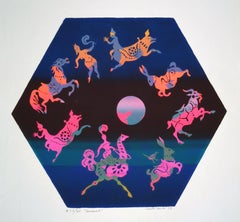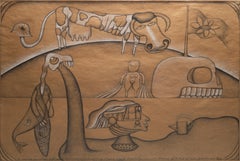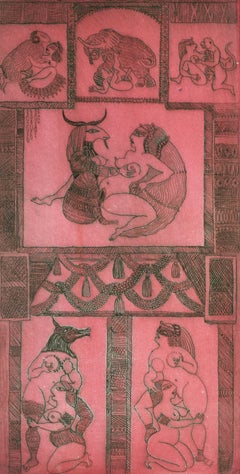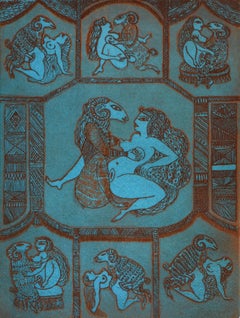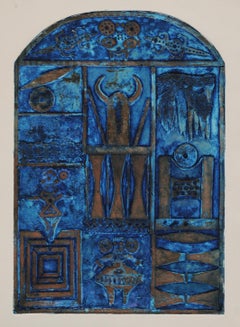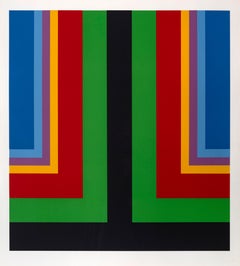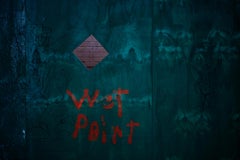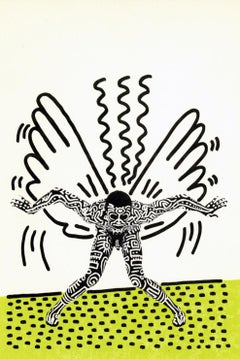Gallery 2112 Prints and Multiples
to
2
3
3
2
2
Overall Width
to
Overall Height
to
1
1
1
1
1
10
2
8
7
3
4
3
2
2
2
1
1
1
1
1
1
9
2
1
1
1
3
10
"Carousel"
Located in Washington, DC
Silkscreen work by Noche Crist (1909- 2004). Marked in pencil 28/30 lower left. Printed in 1973 by the artist. Image is from her "Carrousel" series. Catalogue of a postumous retrospe...
Category
1970s Outsider Art Animal Prints
Materials
Paper, Ink
Surreal Artwork "The Worshiper of a Beautiful Watering Can", 1965
Located in Washington, DC
Wonderful original surreal artwork by German artist Piet Morell (b.1939). Titled in German "The Worshiper of a Beautiful Watering Can". Signed bottom right. Work is B&W pencil on ...
Category
1960s Surrealist More Prints
Materials
Paper, Pencil
$750 Sale Price
50% Off
Women Loving Woomen
Located in Washington, DC
Signed silkscreen work by Noche Crist (1909- 2004). From Women Loving Woomen series. Wonderful work printed by the artist on thick paper. Catalogue of a postumous retrospective in...
Category
1970s Outsider Art Nude Prints
Materials
Paper
Year of the Ram
Located in Washington, DC
Silkscreen work by Noche Crist (1909- 2004). Marked in pencil 3/15 lower left. Printed by the artist in the 1970s. Image is from her Year of the Ram series...
Category
1970s Outsider Art Nude Prints
Materials
Paper
Blue Collograph with Horns
Located in Washington, DC
Appealing collograph Intaglio work by Noche Crist (1909- 2004). Unsigned from the 1970s but one of a kind and handprinted by the artist on thick paper. Catalogue of a postumous retr...
Category
1970s Folk Art Figurative Prints
Materials
Intaglio
Abstract Hard Edge Geometric Silkscreen by Howard Mehring
By Howard Mehring
Located in Washington, DC
Silkscreen by Washington Color School artist Howard Mehring (1931-1978). Work is printed on thick wove paper circa 1970. Work was originally acquired from artists estate and is uns...
Category
1970s Color-Field Abstract Prints
Materials
Archival Paper
André Masson "Judith and Holofernes", 1974
By André Masson
Located in Washington, DC
Signed color lithograph by French artist André Masson (1896-1987). Title of work is Judith and Holofernes. Work is signed and numbered 74/150 in ...
Category
1970s Abstract Abstract Prints
Materials
Archival Paper
"Sitting Bull Goes To Washington"
Located in Washington, DC
Silkscreen work by Noche Crist (1909- 2004). Work is from from her "Sitting Bull Goes to Washington" series. Marked in pencil 15/18 lower left. Printed in 1976 by the artist. Catalo...
Category
1970s Outsider Art Figurative Prints
Materials
Paper
"Succubus Festival"
Located in Washington, DC
Silkscreen work by Noche Crist (1909- 2004). Marked in pencil 7/9 lower left. Printed in 1974 by the artist. Image is from her "Succubus Festival" series. Catalogue of a postumous re...
Category
1970s Outsider Art Nude Prints
Materials
Paper
$338 Sale Price
24% Off
Pink Pop Art "In the Sun", 1960s
Located in Washington, DC
Psychedelic silkscreen work by Noche Crist (1909- 2004). Self printed by the artist. Wonderful work and one of only two remaining from her estate. Image is from her "In the Sun" ser...
Category
1960s Pop Art Abstract Prints
Materials
Paper
Related Items
Wallscape IV ( New York ) - abstraction of urban textures and palimpsest colors
By Frank Schott
Located in San Francisco, CA
WALLSCAPE IV by Frank Schott
from a series of photographic observances capturing urban textures and wallscape color palettes
48 x 72 inches / 122cm x 182...
Category
21st Century and Contemporary Contemporary Color Photography
Materials
Archival Ink, Archival Paper, Photographic Paper, Archival Pigment, Giclée
$3,520 Sale Price
20% Off
H 48 in W 72 in
Keith Haring Into 84 (Keith Haring Bill T. Jones announcement)
By Keith Haring
Located in NEW YORK, NY
Keith Haring Into 84/Keith haring Painted Man 1983:
Announcement card for Keith Haring’s well-documented exhibition, 'Into 84' at Tony Shafrazi Gallery, New York, 1983. For this ser...
Category
1980s Contemporary Nude Prints
Materials
Offset
Nu bleu, la grenouille (Blue Nude, The Frog)
By (after) Henri Matisse
Located in Washington, DC
Artist: Henri Matisse (after)
Title: Nu bleu, la grenouille (Blue Nude, The Frog)
Portfolio: The Last Works of Henri Matisse
Medium: Lithograph
Date: 195...
Category
1950s Nude Prints
Materials
Lithograph
Marc Chagall - The Candlestick - Original Lithograph
By Marc Chagall
Located in Collonge Bellerive, Geneve, CH
The Candlestick, from Jean Leymarie, Vitraux pour Jérusalem (Jerusalem Windows), André Sauret, Monte Carlo, 1962 (see M. 366-72; see C. books ...
Category
1960s Surrealist Figurative Prints
Materials
Lithograph
$2,482
H 12.8 in W 9.65 in D 0.04 in
Bat in the meadow. 1982. Paper, linocut, 20x34 cm
By Dainis Rozkalns
Located in Riga, LV
Bat in the meadow. 1982. Paper, linocut, 20x34 cm
imprint size 10x25,5 cm total page size 20x34cm
Dainis Rozkalns (1928 - 2018)
Artist, graphic artist, illustrator of folklore and ...
Category
1980s Folk Art Animal Prints
Materials
Paper, Linocut
$184 Sale Price
20% Off
H 7.88 in W 13.39 in
The corridor of Katmandu, from The Hippies
By Salvador Dalí
Located in Washington, DC
Artist: Salvador Dali
Title: The corridor of Katmandu
Portfolio: The Hippies
Medium: Etching on Arches wove paper
Date: 1969
Edition: Unnumbered proof
Frame Size: 34 1/4" x 27 1/2"
S...
Category
1960s Surrealist Figurative Prints
Materials
Etching
Carousel, Minimalist Stripe Lithograph by Gene Davis
By Gene Davis
Located in Long Island City, NY
Artist: Gene Davis
Title: Carousel
Year: 1980
Medium: Lithograph on Arches Paper, signed and numbered in pencil
Edition: 250
Image 13.5 x 20 inches
Paper Size: 17 x 24 inches
Category
1980s Color-Field Abstract Prints
Materials
Lithograph
Original Coppertone suntan lotion vintage poster - Italian
Located in Spokane, WA
Original “Coppertone” Colore di Rame vintage Italian poster. Colore de Rame translates into the color of copper.
Abbronzatevi! (suntan)
Non bruciatevi! (don’t burn)
Archival linen-backed in fine condition, ready to frame.
This original Coppertone poster is in A condition.
The background in the poster is a brighter yellow; after all, it is a sunny day, and you need suntan lotion!
Coppertone is an American suntan cream. Interestingly, the American poster of this famous little girl and dog...
Category
1960s American Modern Nude Prints
Materials
Offset
$1,598
H 55 in W 39 in D 0.05 in
Hand painted-Do Not Go Gentle Into that Good Night- the last Artist's Proof of 3
Located in London, GB
This striking extra-large Artist’s Proof is No. 2 of only three in existence. 80% of the painting is hand-painted in oil and gesso on giclee by Shizico Yi, the proof is a unique, one...
Category
2010s Abstract Impressionist Abstract Prints
Materials
Gesso, Ink, Oil, Acrylic, Archival Paper, Giclée
$528
H 47.25 in W 31.5 in D 0.2 in
Marc Chagall - The Red Rider - Original Lithograph
By Marc Chagall
Located in Collonge Bellerive, Geneve, CH
Marc Chagall - Original Lithograph
The Red Rider
From the unsigned, unnumbered lithograph printed in the literary review XXe Siecle
1957
See Mourlot 191
Dimensions: 32 x 24 cm
Publisher: G. di San Lazzaro.
Marc Chagall (born in 1887)
Marc Chagall was born in Belarus in 1887 and developed an early interest in art. After studying painting, in 1907 he left Russia for Paris, where he lived in an artist colony on the city’s outskirts. Fusing his own personal, dreamlike imagery with hints of the fauvism and cubism popular in France at the time, Chagall created his most lasting work—including I and the Village (1911)—some of which would be featured in the Salon des Indépendants exhibitions. After returning to Vitebsk for a visit in 1914, the outbreak of WWI trapped Chagall in Russia. He returned to France in 1923 but was forced to flee the country and Nazi persecution during WWII. Finding asylum in the U.S., Chagall became involved in set and costume design before returning to France in 1948. In his later years, he experimented with new art forms and was commissioned to produce numerous large-scale works. Chagall died in St.-Paul-de-Vence in 1985.
The Village
Marc Chagall was born in a small Hassidic community on the outskirts of Vitebsk, Belarus, on July 7, 1887. His father was a fishmonger, and his mother ran a small sundries shop in the village. As a child, Chagall attended the Jewish elementary school, where he studied Hebrew and the Bible, before later attending the Russian public school. He began to learn the fundamentals of drawing during this time, but perhaps more importantly, he absorbed the world around him, storing away the imagery and themes that would feature largely in most of his later work.
At age 19 Chagall enrolled at a private, all-Jewish art school and began his formal education in painting, studying briefly with portrait artist Yehuda Pen. However, he left the school after several months, moving to St. Petersburg in 1907 to study at the Imperial Society for the Protection of Fine Arts. The following year, he enrolled at the Svanseva School, studying with set designer Léon Bakst, whose work had been featured in Sergei Diaghilev's Ballets Russes. This early experience would prove important to Chagall’s later career as well.
Despite this formal instruction, and the widespread popularity of realism in Russia at the time, Chagall was already establishing his own personal style, which featured a more dreamlike unreality and the people, places and imagery that were close to his heart. Some examples from this period are his Window Vitebsk (1908) and My Fianceé with Black Gloves (1909), which pictured Bella Rosenfeld, to whom he had recently become engaged.
The Beehive
Despite his romance with Bella, in 1911 an allowance from Russian parliament member and art patron Maxim Binaver enabled Chagall to move to Paris, France. After settling briefly in the Montparnasse neighborhood, Chagall moved further afield to an artist colony known as La Ruche (“The Beehive”), where he began to work side by side with abstract painters such as Amedeo Modigliani and Fernand Léger as well as the avant-garde poet Guillaume Apollinaire. At their urging, and under the influence of the wildly popular fauvism and cubism, Chagall lightened his palette and pushed his style ever further from reality. I and the Village (1911) and Homage to Apollinaire (1912) are among his early Parisian works, widely considered to be his most successful and representative period.
Though his work stood stylistically apart from his cubist contemporaries, from 1912 to 1914 Chagall exhibited several paintings at the annual Salon des Indépendants exhibition, where works by the likes of Juan Gris, Marcel Duchamp and Robert Delaunay were causing a stir in the Paris art world. Chagall’s popularity began to spread beyond La Ruche, and in May 1914 he traveled to Berlin to help organize his first solo exhibition, at Der Sturm Gallery. Chagall remained in the city until the highly acclaimed show opened that June. He then returned to Vitebsk, unaware of the fateful events to come.
War, Peace and Revolution
In August 1914 the outbreak of World War I precluded Chagall’s plans to return to Paris. The conflict did little to stem the flow of his creative output, however, instead merely giving him direct access to the childhood scenes so essential to his work, as seen in paintings such as Jew in Green (1914) and Over Vitebsk (1914). His paintings from this period also occasionally featured images of the war’s impact on the region, as with Wounded Soldier (1914) and Marching (1915). But despite the hardships of life during wartime, this would also prove to be a joyful period for Chagall. In July 1915 he married Bella, and she gave birth to a daughter, Ida, the following year. Their appearance in works such as Birthday (1915), Bella and Ida by the Window (1917) and several of his “Lovers” paintings give a glimpse of the island of domestic bliss that was Chagall’s amidst the chaos.
To avoid military service and stay with his new family, Chagall took a position as a clerk in the Ministry of War Economy in St. Petersburg. While there he began work on his autobiography and also immersed himself in the local art scene, befriending novelist Boris Pasternak, among others. He also exhibited his work in the city and soon gained considerable recognition. That notoriety would prove important in the aftermath of the 1917 Russian Revolution when he was appointed as the Commissar of Fine Arts in Vitebsk. In his new post, Chagall undertook various projects in the region, including the 1919 founding of the Academy of the Arts. Despite these endeavors, differences among his colleagues eventually disillusioned Chagall. In 1920 he relinquished his position and moved his family to Moscow, the post-revolution capital of Russia.
In Moscow, Chagall was soon commissioned to create sets and costumes for various productions at the Moscow State Yiddish Theater, where he would paint a series of murals titled Introduction to the Jewish Theater as well. In 1921, Chagall also found work as a teacher at a school for war orphans. By 1922, however, Chagall found that his art had fallen out of favor, and seeking new horizons he left Russia for good.
Flight
After a brief stay in Berlin, where he unsuccessfully sought to recover the work exhibited at Der Sturm before the war, Chagall moved his family to Paris in September 1923. Shortly after their arrival, he was commissioned by art dealer and publisher Ambroise Vollard to produce a series of etchings for a new edition of Nikolai Gogol's 1842 novel Dead Souls. Two years later Chagall began work on an illustrated edition of Jean de la Fontaine’s Fables, and in 1930 he created etchings for an illustrated edition of the Old Testament, for which he traveled to Palestine to conduct research.
Chagall’s work during this period brought him new success as an artist and enabled him to travel throughout Europe in the 1930s. He also published his autobiography, My Life (1931), and in 1933 received a retrospective at the Kunsthalle in Basel, Switzerland. But at the same time that Chagall’s popularity was spreading, so, too, was the threat of Fascism and Nazism. Singled out during the cultural "cleansing" undertaken by the Nazis in Germany, Chagall’s work was ordered removed from museums throughout the country. Several pieces were subsequently burned, and others were featured in a 1937 exhibition of “degenerate art” held in Munich. Chagall’s angst regarding these troubling events and the persecution of Jews in general can be seen in his 1938 painting White Crucifixion.
With the eruption of World War II, Chagall and his family moved to the Loire region before moving farther south to Marseilles following the invasion of France. They found a more certain refuge when, in 1941, Chagall’s name was added by the director of the Museum of Modern Art (MOMA) in New York City to a list of artists and intellectuals deemed most at risk from the Nazis’ anti-Jewish campaign. Chagall and his family would be among the more than 2,000 who received visas and escaped this way.
Haunted Harbors
Arriving in New York City in June 1941, Chagall discovered that he was already a well-known artist there and, despite a language barrier, soon became a part of the exiled European artist community. The following year he was commissioned by choreographer Léonide Massine to design sets and costumes for the ballet Aleko, based on Alexander Pushkin’s “The Gypsies” and set to the music of Pyotr Ilyich Tchaikovsky.
But even as he settled into the safety of his temporary home, Chagall’s thoughts were frequently consumed by the fate befalling the Jews of Europe and the destruction of Russia, as paintings such as The Yellow Crucifixion...
Category
1950s Surrealist Figurative Prints
Materials
Lithograph
$2,896
H 12.6 in W 9.45 in D 0.04 in
"Omniverso" Omniverse - contemporary, surrealist, graphic, geometric sun print
By Pedro Friedeberg
Located in Ciudad de México, MX
The repetition of patterns and rhythm is present in almost every piece of Pedro´s work.
The hybrid topographies that Pedro Friedeberg´s unclassifiable practice recreates we must rec...
Category
21st Century and Contemporary Surrealist Figurative Prints
Materials
Digital
Modernist FOLK ART Original Pencil Lithograph "GRAY DAY AT THE BEACH"
By Doris Lee
Located in New York, NY
Doris Lee
Lithograph
1964
Edition Size: 250
Image Size: 12 x 9.5 inches
Sheet Size: 16.75 x 13 inches
Reference: AAA 1532
Signed lower left
Condition: Good
Provenance: ASA
Doris Emrick Lee...
Category
1960s Folk Art Landscape Prints
Materials
Lithograph, Archival Pigment
$1,100
H 17 in W 13 in D 1 in
